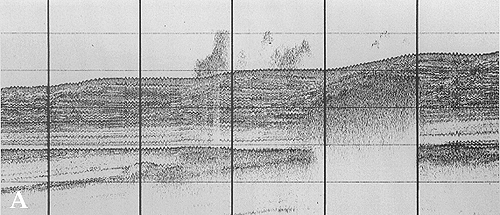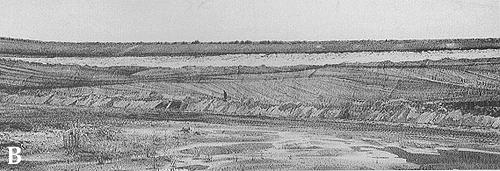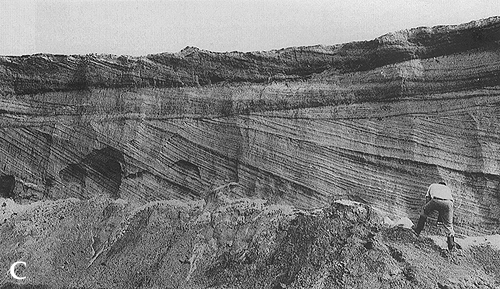


Large-scale subaqueous bed forms (sand waves, sediment waves)
Plate 26



Large-scale subaqueous bed forms (sand waves, sediment waves)
Plate 26
Isolated or repetitive, large-scale bed forms, similar to dunes in many respects, occur under water. They were first discovered by means of echo sounding devices, then "X-radiographed" by acoustic waves. The external profile of these structures was thus known before the internal geometry. The term sand wave is applied when their core is made of sand (B and C); if finer sediment prevails, as is the case in many seismic sections (A, the form is called a sediment wave.
A fundamental difference between sediment waves and classical dunes is the steepness of the slipface. In sediment waves, the foreset slope is gentler and joins tangentially (asymptotically) the bottom. Laminae dipping as much as 20° can be found in sand waves (see C), but on the average their inclination is lower than the angle of repose. This means that the slipface is not protected from current shear or, in other terms, is not subjected to gravity only. Flow conditions and distribution of turbulence near the bottom must consequently be somewhat different in comparison with the eolian setting.
Moreover, rarely do laminae in foresets form a single, conformable set. Unconformities and changes of inclination are visible in long exposures like those of pictures B and C. These features indicate that the migration of the form was not a continuous process: it continued for a while, then stopped and was reactivated when sediment was again available. For this reason, the truncations are called reactivation surfaces. During pauses in migration, erosion possibly occurred, especially in the upper parts of foresets.
The tangential character of the lower foreset (toeset) in sand waves is visible in the two uppermost beds of picture C.
A: 3.5 kHz subbottom profile offshore the Tiber delta, Tyrrhenian Sea. Spacing between horizontal lines is about 9 m; between vertical lines, about 200 m.; B, C: Greensand Formation, Cretaceous, U.K. Person for scale.
Sediment and sand waves have a marked longitudinal asymmetry in both profile and internal bedding. This is the effect of their being produced, like eolian dunes, by a current flowing in a constant direction. But what kind of current produces large bed forms under water? In water masses, enormous amounts of energy are stored. The question is, how concentrated this energy is to do mechanical work. To build up sediment waves, large volumes of materials must be mobilized; furthermore, the sediment moves slowly, particle by particle as in all tractive structures. Consequently, the currents must persist for relatively long times to do their work. Episodic sedimentation and catastrophic events are not adequate: they are too short and cause mass transport.
Oceanographic surveys have found that currents with the necessary requisites can exist both in shallow and in deep-water: tides produce the most persistent and powerful currents in continental shelves (with velocities up to 1,5 m/s near the water surface), geostrophic currents do the same in cold, deeper water. Occasionally, strong winds blowing over long fetches can also produce bottom grazing currents in shallow water.
Most tides have a diurnal or semidiurnal period, and are accompanied by currents that reverse their flow for each semi-period (flood and ebb flows), and so last for some hours. Peaks of velocity (several decimeters per second) and carrying capacity occur for even shorter intervals. Peculiar morphological and oceanographic settings can, however, enhance the power of tidal flows.
Bottom currents related to the global, thermohaline circulation of the oceans, flow from the poles to the Equator. Especially where they find constrictions, their velocity is sufficient to remove sediment and build up sediment waves and drifts. As the currents follow the contour lines of continental margins, the sediment they accumulate is known as contourite. It can be pelagic, terrigenous or hemipelagic.
| Photos: A Institute for Marine Geology 1992; B and C G. G. Ori 1992. |